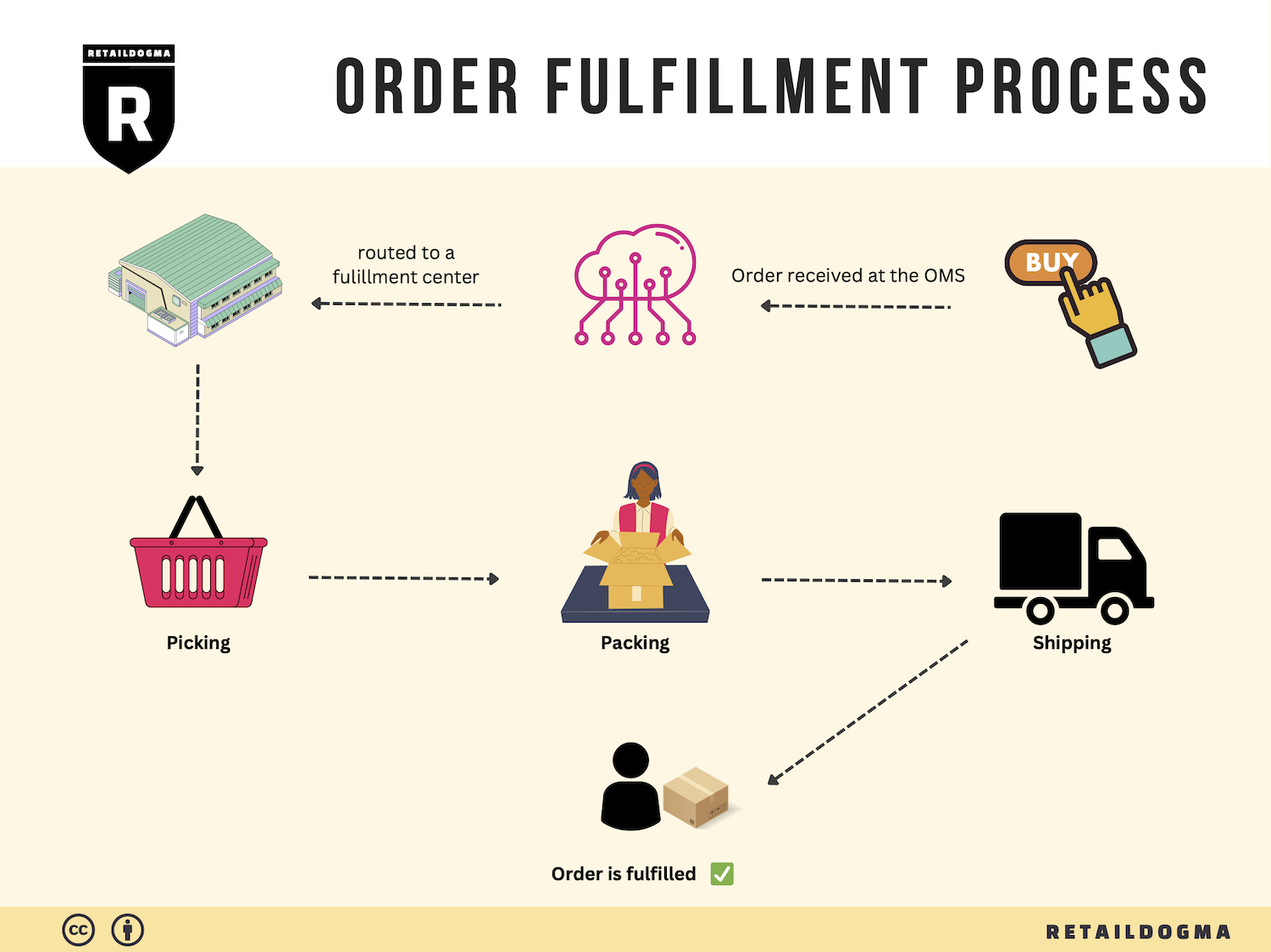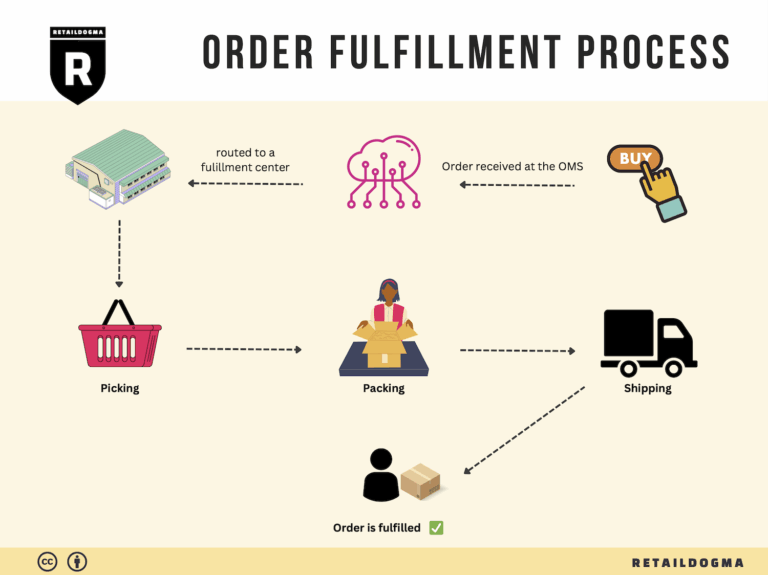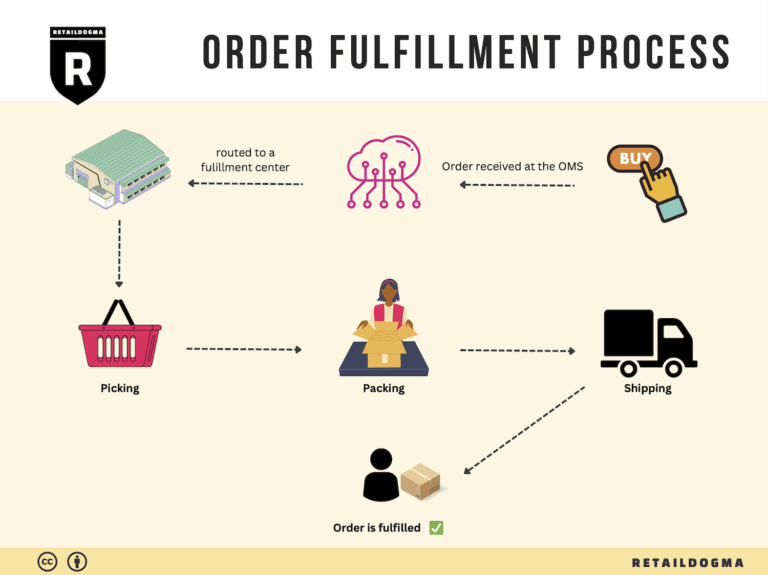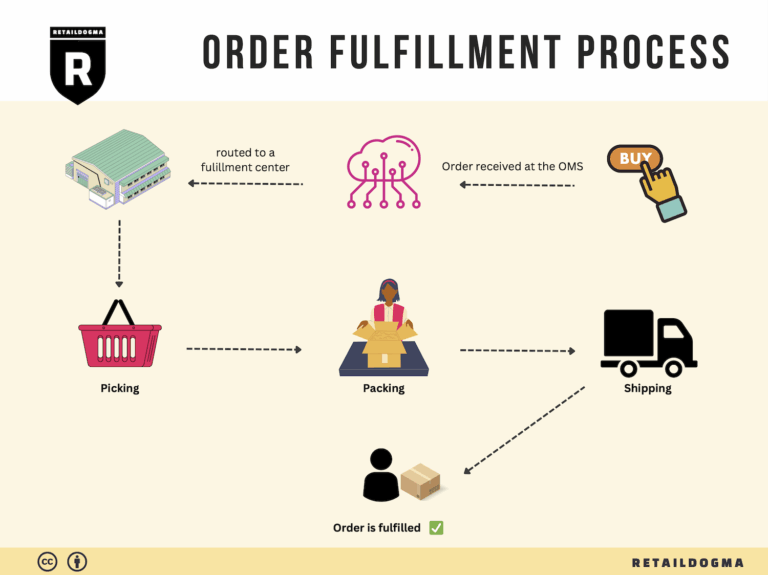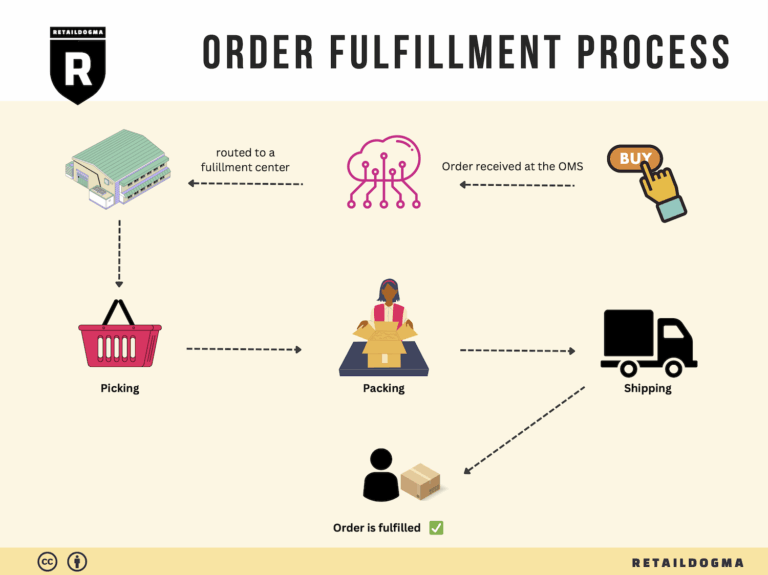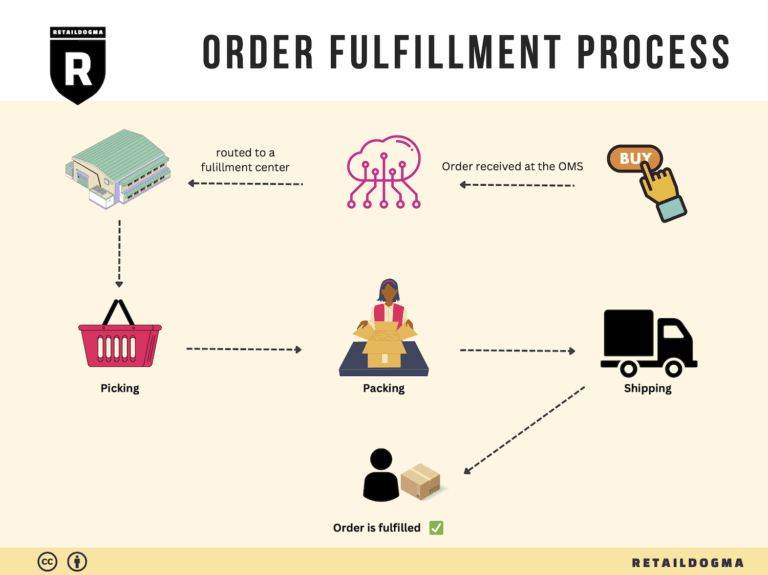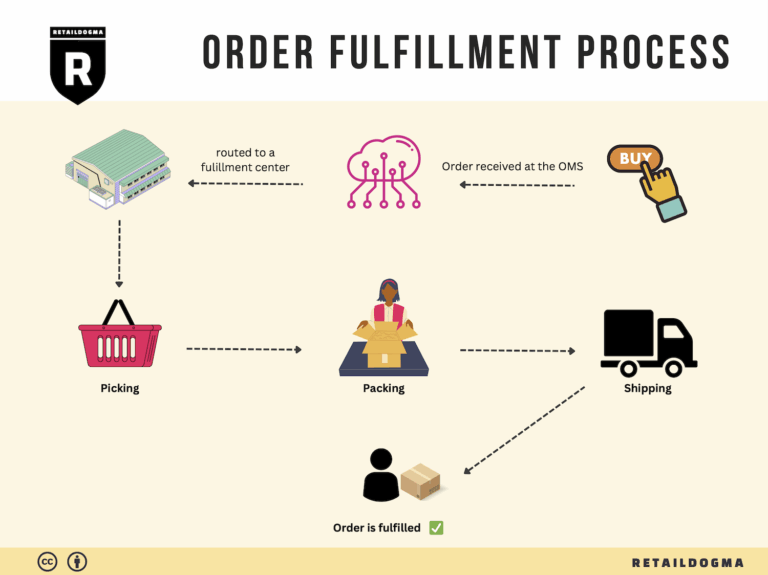Ecommerce Fulfillment Services: The Ultimate Guide (2025)
What is E-commerce Fulfillment? An Introduction for Growing Businesses
Understanding E-commerce Fulfillment
As an e-commerce business owner, the excitement of growing your online store can quickly turn into overwhelming stress when it comes to packing and shipping orders. The process of fulfilling customer orders is often more complex than it seems. It encompasses everything from inventory management to shipping logistics, and if not handled efficiently, it can hinder your growth and customer satisfaction. This is where understanding e-commerce fulfillment becomes crucial.
E-commerce fulfillment is simply defined as the entire process of getting a product from your warehouse or fulfillment center to the customer’s doorstep. This includes receiving inventory, storing products, picking and packing orders, and finally shipping them out. For many growing businesses, mastering this process can be a challenge, especially when demand spikes or when you begin to scale your operations.
In this guide, we will explore various fulfillment models that can cater to your business needs. From Third-Party Logistics (3PL) providers to Fulfillment by Amazon (FBA), each model has its own advantages and considerations. We will delve into the core services offered by these fulfillment partners, such as inventory management, order processing, shipping, and returns handling.
Choosing the right fulfillment partner is essential for ensuring smooth operations. We will provide insights into what factors to consider, including location, technology integration, and service levels. Additionally, understanding pricing structures is vital, as costs can vary significantly between different providers and models. We will break down the key pricing elements you should be aware of, from storage fees to shipping costs.
Ultimately, this guide aims to empower e-commerce businesses to make informed decisions about their logistics strategies. By understanding the intricacies of e-commerce fulfillment, you can streamline your operations, enhance customer satisfaction, and position your business for sustainable growth. Whether you are just starting out or looking to scale your existing operations, this comprehensive overview will equip you with the knowledge needed to navigate the fulfillment landscape effectively.
What You’ll Learn In This Guide
- What is E-commerce Fulfillment? An Introduction for Growing Businesses
- The Order Fulfillment Process: From ‘Buy’ Button to Customer’s Door
- Comparing Fulfillment Models: In-House vs. 3PL vs. Dropshipping
- A Deep Dive into Amazon FBA: Pros, Cons, and Who It’s For
- Core Services Offered by Fulfillment Centers
- How to Choose a Fulfillment Partner: A 6-Point Checklist
- Understanding Fulfillment Pricing: A Breakdown of Common Fees
- Frequently Asked Questions (FAQs) about Fulfillment
- Conclusion: Is Outsourcing Fulfillment the Right Move for Your Business?
- Important Disclaimer
The Order Fulfillment Process: From ‘Buy’ Button to Customer’s Door
1. Receiving Inventory
The order fulfillment process begins with receiving inventory. This is the critical first step where goods are delivered to the warehouse from suppliers or manufacturers. During this stage, it’s essential to check the received items against purchase orders to ensure accuracy in quantity and quality. This process often involves using SKU (Stock Keeping Unit) numbers, which help identify products uniquely and track inventory levels efficiently.
Why is this step important? Proper inventory receipt prevents discrepancies that can lead to stockouts or excess inventory, both of which can harm your business operations. An effective receiving process can significantly reduce errors and improve overall inventory management, ensuring that what is recorded in the system reflects what is physically present in the warehouse.
2. Warehouse Storage
Once the inventory has been received, the next step is warehouse storage. This involves organizing the products within the warehouse for optimal accessibility and efficiency. Items are typically stored based on their SKU and categorized by type, size, or frequency of sale. The use of ABC analysis—a method that categorizes inventory into three classes based on importance—can help prioritize storage space for high-demand items.
The importance of this step lies in maximizing storage space and improving picking efficiency. Properly organized warehouses facilitate quicker access to products, reduce labor costs, and enhance the overall speed of order fulfillment. This organization is vital for ensuring that your fulfillment process remains scalable as your business grows.
3. Order Picking
The order picking process follows storage, where items are retrieved from their locations to fulfill customer orders. This step typically involves generating pick lists, which are documents that outline the items and their locations within the warehouse. Workers use these lists to gather products quickly and accurately.
Why is order picking crucial? It’s one of the most labor-intensive activities in the fulfillment process and directly impacts the accuracy and speed of order fulfillment. Efficient picking strategies, such as batch picking (where multiple orders are picked at once) or zone picking (where pickers are assigned specific areas), can greatly enhance productivity and reduce order processing times.
4. Order Packing
After the items have been picked, they move to the order packing stage. This involves safely packaging the products for shipment, ensuring they are protected during transit. Packing materials, such as bubble wrap, packing peanuts, and sturdy boxes, are critical to prevent damage. During this stage, it’s also essential to include any necessary documentation, such as invoices or return labels.

The significance of packing cannot be overstated; well-packed orders reduce the risk of damage during shipping, leading to higher customer satisfaction and lower return rates. Additionally, implementing a packing slip can help confirm that the correct items are included in the shipment, further enhancing accuracy.
5. Shipping & Delivery
The final step in the order fulfillment process is shipping and delivery. This involves selecting the appropriate shipping method based on the customer’s location and the speed of delivery required. Businesses often use third-party logistics (3PL) providers or carriers to handle this step, leveraging their infrastructure for efficient distribution.
Why is this step critical? The shipping process directly influences customer satisfaction and can affect the overall perception of your brand. Timely and reliable delivery can lead to repeat business and positive reviews. Additionally, utilizing tracking numbers allows customers to monitor their orders in real-time, enhancing transparency and trust in your service.
In conclusion, understanding and optimizing each of these five steps—receiving inventory, warehouse storage, order picking, order packing, and shipping & delivery—are essential for scaling your e-commerce operations effectively. Each phase plays a vital role in ensuring that customers receive their orders accurately and on time, ultimately driving business growth and customer loyalty.
Comparing Fulfillment Models: In-House vs. 3PL vs. Dropshipping
Fulfillment Model Comparison
| Model | Who Handles Inventory | Best For (Business Stage) | Key Advantage | Key Disadvantage |
|---|---|---|---|---|
| In-House Fulfillment | Business itself | Established businesses | Full control over inventory and operations | High fixed costs and resource-intensive |
| Third-Party Logistics (3PL) | 3PL provider | Growing businesses | Scalability and access to expertise | Less control over inventory and potential service variability |
| Dropshipping | Supplier | Startups and small businesses | Low startup costs and minimal risk | Lower profit margins and reliance on suppliers |
In-House Fulfillment
In-house fulfillment involves managing the entire logistics process within your own organization. This model is typically favored by established businesses that have the resources to handle warehousing, inventory management, and shipping internally. The primary advantage of in-house fulfillment is the level of control it provides. Companies can dictate every aspect of their fulfillment process, from inventory handling to shipping times, ensuring that they meet their customers’ expectations. This can lead to improved customer satisfaction and loyalty.
However, the in-house model comes with significant challenges. It requires substantial investment in infrastructure, including warehousing space, technology for inventory management, and a dedicated workforce. As a result, the fixed costs can be high, and the model can be resource-intensive. Additionally, scaling operations quickly can be difficult; if demand surges unexpectedly, businesses may struggle to keep up without incurring additional costs. This model is best suited for businesses that have already established a stable customer base and are looking to maintain direct oversight over their logistics.
Third-Party Logistics (3PL)
Third-party logistics (3PL) providers offer businesses the ability to outsource their fulfillment operations. This model is particularly advantageous for growing businesses that want to scale quickly without the overhead of managing their own logistics. 3PL providers specialize in warehousing, inventory management, and shipping, allowing businesses to leverage their expertise and technology.
The key advantage of using a 3PL is scalability. As a business grows, a 3PL can easily adjust to increased order volumes without requiring the business to invest in additional infrastructure. Additionally, 3PLs often have established networks that can reduce shipping times and costs. However, this model does come with some trade-offs. Businesses may experience less control over their inventory and fulfillment processes, which can lead to inconsistencies in service quality. Furthermore, the reliance on a third party means that any issues with the provider can directly affect customer satisfaction. Companies using 3PL services should carefully evaluate potential partners to ensure they align with their operational goals and customer service standards.
Dropshipping
Dropshipping is a fulfillment model where the retailer does not hold inventory but instead relies on suppliers to ship products directly to customers. This model is particularly appealing for startups and small businesses due to its low startup costs and minimal financial risk. Retailers can offer a wide range of products without the need for upfront investment in inventory, making it easier to test new markets and product lines.
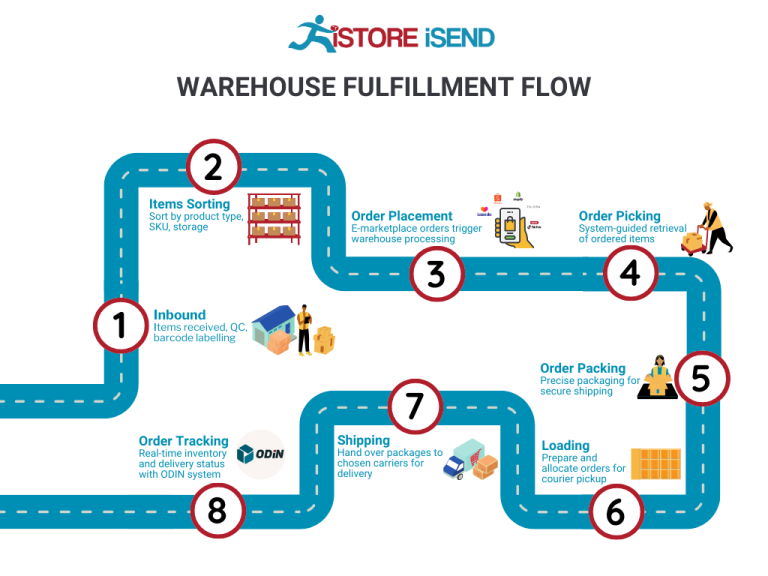
The primary advantage of dropshipping is the flexibility it provides. Retailers can quickly adapt to changing market demands and customer preferences without the burden of inventory management. However, this model also has significant disadvantages. Profit margins can be lower compared to other fulfillment methods, as suppliers often take a larger cut of the sale. Additionally, retailers are at the mercy of their suppliers for inventory levels and shipping times, which can lead to delays and customer dissatisfaction. Businesses considering dropshipping should conduct thorough research to select reliable suppliers and maintain good communication to ensure quality service.
Conclusion
Choosing the right fulfillment model is crucial for e-commerce businesses looking to scale efficiently. Each model—whether in-house, 3PL, or dropshipping—has its own advantages and disadvantages that must be carefully weighed against the business’s specific needs, resources, and growth objectives. By understanding these differences, business owners and operations managers can make informed decisions that align with their strategic goals and enhance their overall customer experience.
A Deep Dive into Amazon FBA: Pros, Cons, and Who It’s For
Understanding Fulfillment by Amazon (FBA)
Fulfillment by Amazon (FBA) is a service that allows e-commerce businesses to leverage Amazon’s extensive logistics network to store, pack, and ship their products. Sellers send their inventory to Amazon’s fulfillment centers, where Amazon takes care of storage, order processing, shipping, and customer service. This service enables sellers to scale their businesses without the burden of managing logistics directly.
How FBA Works
-
Inventory Shipment: Sellers prepare and ship their products to Amazon’s fulfillment centers. Each product must be labeled correctly, and sellers can choose to use Amazon’s labeling service for a fee.
-
Storage: Once the inventory arrives at the fulfillment center, Amazon stores it until a customer places an order.
-
Order Processing: When a customer orders a product, Amazon picks, packs, and ships it on behalf of the seller. This includes handling all aspects of order fulfillment, from packaging to delivery.
-
Customer Service: Amazon provides customer service for FBA orders, including handling returns and refunds, which can greatly reduce the workload for sellers.
-
Payment: After the product is sold, Amazon collects payment from the customer and transfers the proceeds (minus fees) to the seller’s account.
Pros of Using FBA
1. Prime Eligibility
One of the most significant advantages of FBA is that products become eligible for Amazon Prime. This means that Prime members can receive free two-day shipping, which can significantly enhance sales potential. Many customers prefer to buy from Prime-eligible listings due to the perceived value of faster shipping.

2. Increased Customer Trust
Products fulfilled by Amazon often enjoy a higher level of customer trust. Buyers are reassured by Amazon’s reputation for reliability and customer service. This can lead to increased conversion rates compared to non-FBA sellers.
3. Multi-Channel Fulfillment
FBA is not limited to Amazon sales alone. Sellers can use FBA to fulfill orders from other platforms, such as their own websites or eBay. This multi-channel fulfillment capability allows businesses to streamline operations and manage inventory more effectively across various sales channels.
4. Scalability
FBA allows businesses to scale quickly without the need to invest heavily in warehousing and logistics. Sellers can send larger quantities of inventory to Amazon, confident that their products will be handled efficiently, allowing them to focus on growth and marketing.
5. Access to Advanced Tools
Using FBA provides sellers access to Amazon’s advanced tools and analytics. This includes inventory management, sales tracking, and performance metrics, which can help sellers make informed decisions about their business strategies.
Cons of Using FBA
1. High Fees
While FBA offers many benefits, it also comes with significant costs. Sellers must pay storage fees based on the amount of space their inventory occupies in Amazon’s warehouses, as well as fulfillment fees for each unit sold. These fees can quickly add up, especially for low-margin products.
2. Strict Inventory Rules
Amazon has strict policies regarding inventory management. Sellers must adhere to guidelines for product condition, labeling, and packaging. Failure to comply can result in additional fees or even the removal of inventory from Amazon’s fulfillment centers.
3. Commingling Risks
FBA employs a commingling policy, meaning that your inventory may be mixed with that of other sellers. This can create complications, especially if a customer receives a defective or counterfeit item. Sellers can opt out of commingling, but this may lead to higher fulfillment costs.
4. Loss of Control
Using FBA means relinquishing some control over the fulfillment process. Sellers depend on Amazon for shipping accuracy, inventory management, and customer service. Any issues that arise can affect the seller’s reputation.
5. Inventory Limitations
Amazon imposes limits on how much inventory sellers can send to fulfillment centers, particularly for new sellers. These limits can restrict growth potential and necessitate careful inventory planning.
Who is FBA Best For?
Fulfillment by Amazon is best suited for:
-
Established Sellers: Businesses with a track record of sales on Amazon can benefit from the increased visibility and trust that comes with FBA.
-
Small to Medium-Sized Businesses: Companies looking to scale their operations without the overhead of logistics and warehousing can find FBA to be a cost-effective solution.
-
Sellers with High-Volume Products: Businesses that sell fast-moving consumer goods can take advantage of the efficiency and speed of FBA, maximizing sales potential through Prime eligibility.
-
Multi-Channel Sellers: Those selling on multiple platforms can simplify operations by using FBA for fulfillment across different sales channels.
-
New Entrepreneurs: Startups looking to enter the e-commerce space without significant upfront investment in logistics may find FBA to be an appealing option.
In conclusion, Fulfillment by Amazon offers e-commerce businesses a robust logistics solution that can drive growth and enhance customer satisfaction. However, it is essential for sellers to weigh the pros and cons carefully to determine if FBA aligns with their business goals and operational capabilities. By understanding the intricacies of FBA, sellers can make informed decisions that will help them scale effectively in the competitive e-commerce landscape.
Core Services Offered by Fulfillment Centers
Inventory Management & Warehousing
Inventory management and warehousing are foundational services provided by fulfillment centers, enabling e-commerce businesses to maintain optimal stock levels while minimizing overhead costs. This service involves the systematic tracking and organization of products stored within a fulfillment center. Advanced inventory management systems utilize technology to provide real-time data on stock levels, order status, and product locations, ensuring that businesses have accurate visibility into their inventory.
Benefits:
1. Cost Efficiency: By outsourcing inventory management, businesses can reduce the need for physical warehouse space and associated costs, such as utilities and staffing. Fulfillment centers typically have economies of scale that allow them to operate more efficiently than individual businesses.
2. Reduced Risk of Stockouts and Overstocks: Effective inventory management helps prevent stockouts, which can lead to lost sales, and overstocks, which can tie up capital. With precise inventory data, businesses can make informed decisions about restocking and product discontinuation.
3. Scalability: As e-commerce businesses grow, their inventory needs can fluctuate dramatically. Fulfillment centers provide the flexibility to scale up or down based on demand without the need for long-term commitments to storage space.
Pick and Pack Services
Pick and pack services are critical to the order fulfillment process, where individual items are selected (picked) from inventory and packed into shipping boxes for delivery to customers. Fulfillment centers employ sophisticated systems and trained staff to ensure that orders are accurately filled and efficiently packaged.
Benefits:
1. Speed and Accuracy: Fulfillment centers utilize automated systems and trained personnel to expedite the picking process, reducing the time it takes to fulfill orders. This efficiency is crucial for meeting customer expectations for fast delivery.
2. Customization: Many fulfillment centers offer customizable packaging options, allowing e-commerce businesses to present their brand effectively. Custom packing materials and branding can enhance the customer experience and promote brand loyalty.
3. Error Reduction: Automated picking systems and quality control checks help minimize human error during the picking process. This accuracy is vital in maintaining customer satisfaction and reducing return rates.
Kitting and Assembly
Kitting and assembly refer to the process of grouping individual items into ready-to-ship kits or assembling products before they are sent out to customers. This service is particularly beneficial for businesses that sell products that require bundling or assembly, such as subscription boxes or DIY kits.
Benefits:
1. Enhanced Product Offerings: Kitting allows businesses to create unique product bundles that can attract new customers and increase average order value. For example, a company selling outdoor gear might offer a camping kit that includes a tent, sleeping bag, and cooking gear.
2. Streamlined Operations: By outsourcing kitting and assembly, e-commerce businesses can focus on their core competencies, such as marketing and product development, while leaving the logistics of product preparation to experts.
3. Improved Inventory Control: Kitting services can help businesses manage inventory more effectively by consolidating multiple SKUs into a single kit SKU, simplifying inventory tracking and forecasting.
Returns Management (Reverse Logistics)
Returns management, or reverse logistics, is an essential service that handles the process of returned goods. This includes receiving, inspecting, restocking, and managing the logistics of returned items. Effective returns management is crucial for maintaining customer satisfaction and loyalty, as it directly impacts the customer experience.
Benefits:
1. Customer Retention: A streamlined returns process enhances customer satisfaction and fosters loyalty. When customers know they can easily return products, they are more likely to make a purchase, knowing they have the option to return if necessary.
2. Cost Savings: Efficient returns management minimizes the costs associated with processing returns, such as shipping and restocking fees. Fulfillment centers can leverage their logistics networks to optimize return shipping, reducing expenses.
3. Data Insights: Analyzing return data can provide valuable insights into product performance and customer preferences. Understanding why products are returned can help businesses make informed decisions about product improvements and inventory management.
In conclusion, partnering with a fulfillment center for these core services can significantly enhance an e-commerce business’s operational efficiency, customer satisfaction, and overall scalability. By leveraging the expertise and resources of fulfillment centers, businesses can focus on growth and innovation while ensuring that their logistics are handled professionally and effectively.
How to Choose a Fulfillment Partner: A 6-Point Checklist
Location & Warehouse Network
Importance: The geographical location of your fulfillment partner’s warehouses can significantly impact shipping times, costs, and overall customer satisfaction. Proximity to your target market can reduce transit times and shipping fees, which is crucial for maintaining competitive advantage.
Questions to Ask:
– Where are your warehouses located, and how do they align with my primary customer demographics?
– What is your shipping range and average delivery time for key regions?
– Do you have a network of warehouses that can accommodate seasonal fluctuations in demand?
Technology & Integrations
Importance: In today’s digital economy, the ability to seamlessly integrate your e-commerce platform with your fulfillment partner’s technology is vital. A robust technology stack enables real-time inventory tracking, order processing, and data analytics, which enhances operational efficiency.
Questions to Ask:
– What technology do you use for order management, inventory tracking, and reporting?
– Can your systems integrate with my existing e-commerce platform (e.g., Shopify, WooCommerce)?
– Do you offer real-time tracking for orders and inventory, and how can I access this information?
Specializations (e.g., cold storage, oversized items)
Importance: Different businesses have unique fulfillment needs based on the types of products they sell. If your business requires specialized storage (such as cold storage for perishables) or handling (like oversized items), it’s crucial to partner with a fulfillment service that has the necessary capabilities.
Questions to Ask:
– What types of products do you specialize in handling, and do you have the necessary facilities for my specific needs?
– How do you manage the storage and distribution of specialized items?
– Can you provide case studies or references from similar businesses that you have successfully serviced?
Scalability & Capacity
Importance: As your business grows, your fulfillment needs will change. A good fulfillment partner should be able to scale operations up or down based on your business demands, including seasonal spikes in orders or expansion into new markets.
Questions to Ask:
– What is your current capacity for handling orders, and how quickly can you scale up if my order volume increases?
– How do you manage seasonal fluctuations in demand, and what strategies do you have in place for peak seasons?
– Are there any limitations to your scalability that I should be aware of?
Pricing and Contracts
Importance: Understanding the pricing structure and contract terms is essential to avoid unexpected costs that can impact your bottom line. Transparent pricing helps you make informed decisions and budget effectively for fulfillment expenses.
Questions to Ask:
– Can you provide a detailed breakdown of your pricing structure, including any hidden fees (e.g., storage, pick and pack, shipping)?
– What are the terms of your contracts, and are there penalties for early termination?
– How do you handle price adjustments, and what is the process for renegotiating terms as my business evolves?
Customer Support & Reviews
Importance: Exceptional customer support is crucial in the fast-paced e-commerce landscape. A responsive and knowledgeable support team can help resolve issues quickly, ensuring minimal disruption to your operations. Additionally, reviews from other clients can provide insights into the reliability and quality of service.
Questions to Ask:
– What customer support options do you offer (e.g., phone, email, live chat), and what are your response times?
– Can you share testimonials or case studies from current clients regarding your service quality?
– How do you handle disputes or issues with orders, and what is the escalation process?
Conclusion
Choosing the right fulfillment partner is a critical decision that can significantly affect your e-commerce operations and customer satisfaction. By carefully evaluating potential partners using this checklist, you can ensure that you select a fulfillment service that aligns with your business goals, meets your specific needs, and supports your growth strategies. Take the time to ask the right questions and assess each potential partner thoroughly to build a successful and efficient logistics operation.
Understanding Fulfillment Pricing: A Breakdown of Common Fees
Initial Setup Fees
Initial setup fees are one-time charges incurred when you start using a fulfillment service. These fees can cover various tasks such as account creation, system integration, and any required onboarding processes. The fee can vary based on the complexity of your business needs and the fulfillment provider’s setup procedures. Typically, this fee ranges from $50 to several hundred dollars, depending on the service provider.
To calculate the initial setup fee, consider the following factors:
– Complexity of Integration: If your e-commerce platform requires extensive customization or integration with existing systems, expect higher fees.
– Volume of Products: Providers may charge more if you have a large number of SKUs that need to be configured within their system.
– Training Needs: If staff training on the new system is necessary, this could also add to the initial cost.
Receiving Fees
Receiving fees are charged when the fulfillment center accepts and processes your inventory. This fee typically covers the labor involved in unloading, inspecting, and entering the products into the inventory management system.
Receiving fees can be calculated based on:
– Per Unit Basis: Some providers charge a fee for each unit received, which can range from $0.20 to $2.00.
– Hourly Rate: Others may charge based on the time it takes to receive and process shipments, typically calculated at an hourly rate for the workforce involved.
It’s essential to communicate with your fulfillment partner about how they handle receiving and what their specific fee structure looks like.
Storage Fees (per pallet/bin)
Storage fees are ongoing costs associated with keeping your inventory in the fulfillment center. These fees are typically assessed on a monthly basis and can vary based on the size of your inventory and the specific storage requirements.
Storage fees can be calculated in several ways:
– Per Pallet: A common model charges a fixed rate per pallet stored, often ranging from $10 to $50 per month, depending on the provider and location.
– Per Bin: If your inventory is stored in bins or shelves, the charge may be per bin, which typically costs less than pallet storage.
– Volume-Based: Some providers might charge based on the total cubic footage of the stored items.
Understanding the storage model used by your fulfillment partner is crucial, especially if you plan to scale your inventory over time.
Pick & Pack Fees (per item/order)
Pick and pack fees are incurred each time an order is processed. This includes locating the items in the warehouse (picking), packing them securely for shipping, and preparing them for dispatch.
These fees can vary significantly based on:
– Per Item: Many fulfillment centers charge a fee for each item picked and packed, which could range from $0.50 to $3.00 per item.
– Per Order: Some providers may charge a flat fee per order, regardless of the number of items, which can be beneficial for orders with multiple items.
– Complexity of Packing: If your items require special handling or custom packaging, additional fees may apply.
It’s advisable to discuss your specific packing needs with the provider to get an accurate estimate.
Shipping Fees
Shipping fees cover the cost of transporting packages from the fulfillment center to the customer. These fees can vary widely based on several factors, including:
– Destination: Shipping costs increase with distance and vary depending on whether the shipment is domestic or international.
– Shipping Method: Options may include standard, expedited, or overnight shipping, each with different pricing structures.
– Weight and Dimensions: Heavier or larger packages typically incur higher shipping fees, calculated based on weight, size, and carrier rates.
When evaluating shipping costs, consider negotiating with your fulfillment partner to secure better rates, especially if you anticipate high shipping volumes.
Tips for Getting an Accurate Quote
-
Provide Detailed Information: When requesting a quote, offer comprehensive details about your inventory size, order volume, and specific needs (e.g., custom packaging, special handling).
-
Ask About Hidden Fees: Inquire about any additional costs that may not be immediately apparent, such as fees for returns, inventory audits, or seasonal fluctuations.
-
Compare Multiple Providers: Don’t settle for the first quote. Compare offers from several fulfillment services to ensure you’re getting a competitive rate.
-
Understand the Terms: Clarify the terms of the contract, including cancellation policies and any potential changes in pricing as your business scales.
-
Request a Breakdown of Costs: A detailed breakdown will help you understand how each component contributes to the overall cost, allowing for better budgeting and financial planning.
By understanding these common fulfillment pricing models and following these tips, e-commerce business owners can make informed decisions that align with their growth strategies.
Frequently Asked Questions (FAQs) about Fulfillment
1. What is Yucan Fulfillment Service for Temu?
Yucan Fulfillment Service for Temu is a logistics solution designed to help e-commerce businesses manage their inventory, order processing, and shipping needs efficiently. It focuses on integrating with the Temu platform, allowing sellers to streamline their operations and improve delivery times.
2. How does Yucan Fulfillment Service work?
Yucan Fulfillment Service operates by receiving inventory from sellers, storing it in their fulfillment centers, and handling all aspects of order fulfillment. When a customer places an order on Temu, Yucan picks, packs, and ships the product directly to the customer, ensuring quick and reliable delivery.
3. What are the benefits of using Yucan Fulfillment Service for Temu?
Using Yucan Fulfillment Service offers several benefits, including:
– Efficiency: Streamlined processes for order handling and shipping.
– Scalability: Ability to scale operations quickly during peak seasons or growth phases.
– Cost-Effectiveness: Reduced shipping rates through established partnerships.
– Focus on Core Business: Allows businesses to concentrate on marketing and product development rather than logistics.
4. How much do fulfillment services cost?
The cost of fulfillment services can vary widely based on factors such as storage space, order volume, and shipping destinations. Yucan typically charges a combination of storage fees (monthly) and fulfillment fees (per order). It’s advisable to request a quote based on your specific needs to understand the pricing structure.
5. What is the difference between a warehouse and a fulfillment center?
A warehouse is primarily used for storing goods, while a fulfillment center is a specialized facility designed to process orders and ship products directly to customers. Fulfillment centers often include advanced technology for inventory management and logistics, allowing for faster order processing and shipping.
6. What is a 3PL (Third-Party Logistics)?
A 3PL, or Third-Party Logistics provider, is a company that offers outsourced logistics services, including warehousing, transportation, and order fulfillment. Yucan Fulfillment Service acts as a 3PL for businesses using Temu, allowing them to leverage logistics expertise without managing these operations in-house.
7. How can I integrate Yucan Fulfillment Service with my Temu store?
Integration typically involves setting up an account with Yucan and connecting it to your Temu seller account. Yucan provides guidance and support to ensure that your inventory and order data sync seamlessly, enabling automated order processing.
8. What types of products can Yucan Fulfillment Service handle?
Yucan Fulfillment Service can manage a wide variety of products, including electronics, clothing, accessories, and home goods. However, it’s essential to check with Yucan for any specific restrictions or guidelines regarding hazardous materials or perishable items.
9. How does Yucan ensure timely delivery?
Yucan Fulfillment Service utilizes strategic partnerships with shipping carriers and employs efficient logistics practices to ensure timely delivery. They monitor shipping times closely and provide tracking information, allowing sellers and customers to stay informed about their orders.
10. What customer support does Yucan Fulfillment Service offer?
Yucan provides comprehensive customer support, including assistance with integration, order management, and troubleshooting. Sellers can typically reach out via email or phone, and Yucan often offers resources such as FAQs and guides to help users navigate the fulfillment process efficiently.
Conclusion: Is Outsourcing Fulfillment the Right Move for Your Business?
Evaluating the Benefits of Outsourcing Fulfillment
Outsourcing fulfillment can be a transformative decision for e-commerce businesses aiming to scale efficiently. By leveraging a fulfillment service like Yucan, businesses can save significant time and resources. This allows entrepreneurs and operations managers to redirect their focus toward strategic growth initiatives rather than the logistical complexities of inventory management and order processing.
Additionally, partnering with a fulfillment service enhances scalability. As your business experiences fluctuations in demand—whether due to seasonal trends or marketing campaigns—a dedicated fulfillment partner can adjust capacity swiftly, ensuring that your operations remain seamless and responsive. This flexibility is crucial for maintaining customer satisfaction and capitalizing on market opportunities.
Moreover, fulfillment services bring a wealth of expertise to the table. Experienced partners understand the intricacies of shipping, customs regulations, and efficient inventory management, which can significantly reduce the risk of errors and delays. This expertise not only improves your operational efficiency but also enhances your brand’s reputation in the marketplace.
However, the success of outsourcing fulfillment largely depends on selecting the right partner. It’s essential to conduct thorough research and evaluate potential fulfillment services based on their track record, technology, and customer support. A misaligned partnership can lead to challenges that negate the benefits of outsourcing.
Next Steps for Your Business
To determine if a fulfillment service is the right move for your business, consider conducting an audit of your current shipping and fulfillment processes. Analyze your operational bottlenecks, customer feedback, and overall efficiency. This assessment will provide valuable insights into whether outsourcing could propel your business forward. By making informed decisions today, you can set the stage for sustainable growth tomorrow.
Important Disclaimer
⚠️ Important Disclaimer
The information in this guide is for educational purposes. Fulfillment services, pricing, and platform features change frequently. Always conduct your own due diligence and consult with providers directly before making business decisions.
